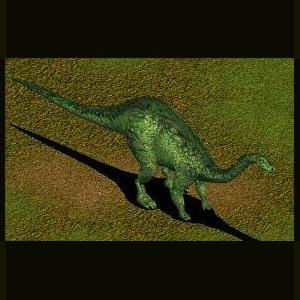About This File
Nigersaurus (meaning Niger lizard) was a relatively small sauropod (15 meters long) that was described in 1999, and which lived in the middle Cretaceous period, about 119-99 million years ago.
It is one of the most common genera found in the rich fossil vertebrate fauna of the Elrhaz Formation, Gadoufaoua, in the Niger Republic, discovered by Philippe Taquet, and described in a paper published in 1976. Like other sauropods from what used to be Gondwana, it had a shorter neck than Laurasian sauropods like Barosaurus. Nigersaurus had to protect itself from carnivores such as Sarcosuchus.
Nigersaurus (meaning Niger lizard) is a genus of diplodocoid sauropod dinosaur from the middle Cretaceous period, about 119 to 99 million years ago during the Aptian or Albian age. This dinosaur was described by Paul Sereno and colleagues in 1999. It is one of the most common genera found in the rich fossil vertebrate fauna of the Elrhaz Formation, Gadoufaoua, in the Niger Republic, discovered by Philippe Taquet, and described in a paper published in 1976.
Nigersaurus was a plant-eater that had an unusual mouth shaped like the wide intake slot of a vacuum that took in food and over a hundred very small, sharp teeth for chewing. Previously, such tooth batteries have been known only in hadrosaur and ceratopsian dinosaurs, but the discovery of Nigersaurus showed that at least one sauropod lineage, the rebbachisaurids, had them, as well.
Like other sauropods from what used to be Gondwana, it had a shorter neck than Laurasian sauropods like Barosaurus. Despite these stockier proportions, Nigersaurus reached about 9 meters (29.5 ft) in length. At nine meters in length, Nigersaurus was smaller than other members of the Rebbachisaur family, such as Rebbachisaurus itself, a large animal with a distinctive low spinal ridge on its back. Nigersaurus, although smaller, had a similar ridge, which in life would have consisted of skin and perhaps also flesh stretched across elongate neural spines in the vertebrae.
Although a common genus, Nigersaurus had been poorly known until 2005, because of the delicate and highly pneumatic (filled with air spaces) construction of the skull and skeleton, which means that the fossil remains have been disarticulated. Sereno and Jeffrey A. Wilson in 2005 provided the first description of the skull and feeding adaptations. Nigersaurus had as many as 500 or 600 teeth in its shovel-shaped head. Like the earlier diplodicids, its head was oriented downwards and was best suited for low level browsing.
According to the New York Times, an article published in the Public Library of Science (PLoS) in late November 2007 details the unique anatomy of Nigersaurus. The genus is reported to have had a relatively short neck with the head oriented towards the ground; it is thought to have been a ground-level browser like a modern cow. The Times reports
In contrast to other plant-eating dinosaurs, this one had more than 50 columns of teeth, all lined up along the jaws’ front edges, forming, in effect, foot-long scissors. The CT scans of the jawbones showed up to nine replacement teeth stacked behind each cutting tooth. When one wore out, another immediately took its place, at a rate, perhaps, of one a month in each column. 'Among dinosaurs,' Dr. Sereno said, 'Nigersaurus sets the Guinness record for tooth replacement.'



Recommended Comments
There are no comments to display.
Create an account or sign in to comment
You need to be a member in order to leave a comment
Create an account
Sign up for a new account in our community. It's easy!
Register a new accountSign in
Already have an account? Sign in here.
Sign In Now